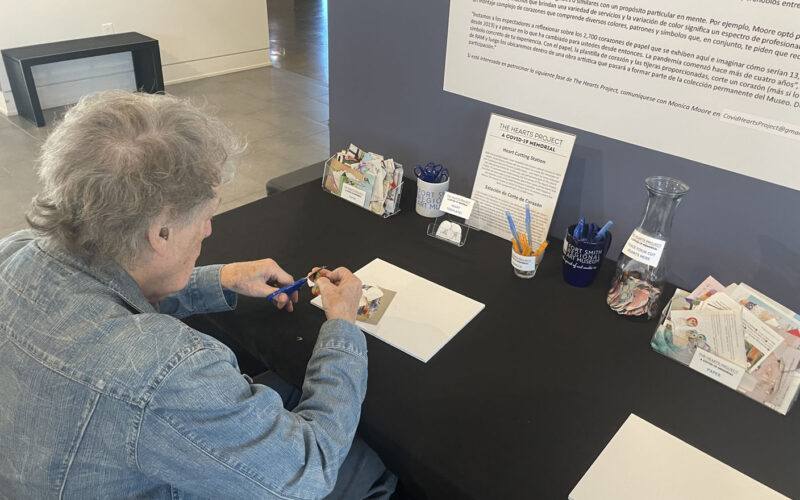Dustin Staggs
NWA Democrat-Gazette
As visitors make their way through the lobby of the Fort Smith Regional Art Museum (RAM) and up the stairs, they are met with a simple yet profound installation: 2,700 hand-cut paper hearts, each symbolizing an Arkansan who died as a result of covid-19.
“The Hearts Project,” designed by local artist Monica Moore, is a memorial dedicated to honoring those lives and urging people to think of the long-term effects of the public health calamity that impacted the world.
The exhibition is on display until Dec. 1 and showcases the first 20% of the project — 2,700 hearts delicately arranged in three custom-made frames, honoring the healthcare workers, frontline workers and lost loved ones. Each of the three frames has nine panels with 100 hearts.
The installation asks viewers to take in what that large amount of hearts looks like together. But it also asks them to envision the remaining 13,068 (the total number of covid-19 deaths in Arkansas when Moore began pursuing this project) or even 1,209,561 hearts — the current figure since Jan. 1, 2020 in the U.S., according to the Center for Disease Control and Prevention.
Moore’s endeavor began as a personal act of coping. She initially started cutting paper hearts out of catalogs, periodicals and antique fashion materials to deal with the grief and emotions she felt during the early days of the pandemic. She couldn’t say for sure why she went with hearts; it just felt right to do at the time.
This ritual of cutting them out reminded her of her high school trip to Japan, where she learned about students making origami peace cranes to memorialize those who died in Hiroshima. She then imagined if each of the hearts could represent a person who died from covid-19 in Arkansas and wondered what the full amount of those hearts would look like together.
Cutting hearts became Moore’s daily meditation, a quiet and repetitive act of memory that took over her dining room table. Moore understood she needed aid in the endeavor as the pandemic progressed and the number of hearts reached thousands. She issued a call for volunteers on social media, and others immediately joined the project.
Alice Dawson cut hearts in commemoration of her niece Danielle Kater, who died from covid-19. Lovingly known by those close to her as Dani, she was not an Arkansan but Dawson is, and her hearts served as the “A Spiritual Crossing” frame’s bright and emotive focal point.
Dawson was unable to attend Kater’s funeral due to the pandemic’s limitations. She channeled her grief around the anniversary of Kater’s death, which was close to her birthday in December, by cutting paper hearts from the things Kater enjoyed.
Dawson talks about how Kater loved reading and always had a book or two in her hands. Both she and her husband were musicians and loved playing music. She rode horses and had a great love for animals. Dawson said her niece was also well-traveled by age 30. When cutting her hearts, Dawson kept these thoughts in mind and also tried to use Kater’s favorite colors, like the ones she had in her wedding.
“I think I got to the point where it became about the statistics of covid and I really wanted to focus on the fact that she was a person,” Dawson said.
These hearts, prominently displayed in the frame in the form of a colorful cross, represent Kater’s spirit and the connection between loss and recollection. Floral panels in the four corners pay homage to the burial custom, with yellow components referencing another covid-19 memorial, “Faces of Covid: Yellow Hearts Memorial,” curated and created by covid-19 survivor advocate Rosie Davis.
While Moore’s “Hearts Project” is personal, it evolved into a collaborative project with those who believed in the need of remembering the pandemic.
Volunteers assisted Moore in hand-cutting the hundreds of purple hearts on display in honor of health professionals who were working in the field. One was Laura Avila, who was a junior in high school at the time and co-president of Fayetteville High School’s National Art Honor Society. Other collaborators were Joel Doelger, who helped with the woodworking, and Jennifer Linton, who provided advice on the frame design. Others are listed in the exhibit’s paper pamphlet available at RAM.
Each heart signifies not only a person lost, but also a point in time when the pandemic’s toll appeared too great to bear. Moore said she interprets the recurrence of the hearts as a metaphor for the repeating nature of grieving, in which each fresh loss adds to an already overwhelming sensation of mourning.
In addition to remembering those who died, “The Hearts Project” encourages viewers to consider their own experience during the pandemic. Moore wants people to pause and think about how the world has changed and hopefully develop a desire to do things differently if there is another public health emergency, she said.
“We were all impacted by covid in some way, and so we want people to be moved,” Moore said. “We want people to remember.”
While “The Hearts Project” is now on display at RAM, Moore has ideas for its future. She plans to create additional frames to symbolize the total number of covid-19 deaths in Arkansas and is already contemplating potential settings for such installations, such as the Washington Regional Medical Center, Fayetteville Public Library and the Creative Community Center in Fayetteville.
Though the show will be removed after Dec. 1, Moore said she thinks its impact will continue after, as the project’s goal is about remembering and never forgetting.
—
FAQ
“The Hearts Project”
WHEN — Exhibit is up until Dec. 1.
WHERE — Fort Smith Regional Art Museum, 1601 Rogers Ave., Fort Smith
COST — Free to attend.
INFO — fsram.org/covid-19-hearts-project



